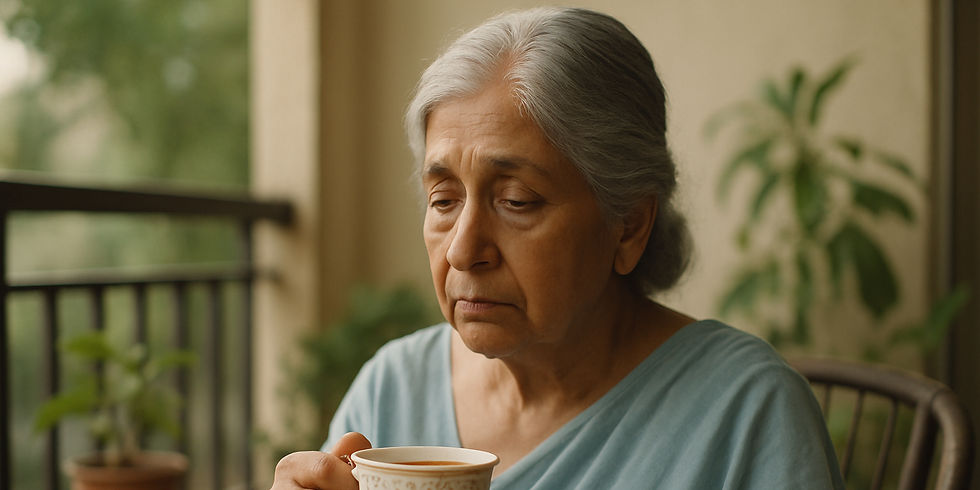Understanding Apraxia in Dementia: What It Is and How You Can Help
- saqlainm5
- Apr 18
- 3 min read
Dementia affects the brain in many complex ways, and one of the most misunderstood symptoms is apraxia, or the loss of purposeful movement. At Home and Community Care Ltd. (HCCL), we believe that understanding the daily challenges people with dementia face is key to delivering better care and maintaining dignity at every stage.
Apraxia is one of the seven common cognitive changes associated with dementia, part of the “7 A’s” tool used to explain how this disease affects brain function:
Anosognosia – Loss of insight
Amnesia – Loss of memory
Aphasia – Loss of language
Agnosia – Loss of recognition
Apraxia – Loss of purposeful movement
Altered perception – Loss of perceptual acuity
Apathy – Loss of initiative
🧠 What Is Apraxia?
A person with apraxia may know exactly what they want to do, understand instructions, and have no physical limitation in their muscles—but still be unable to perform a task. That’s because the brain can no longer coordinate learned, voluntary movements.
This can affect everything from using a spoon to buttoning a shirt—even when the person has done these tasks for years.
Apraxia is often seen alongside aphasia (language issues) and agnosia (recognition issues), adding complexity to daily caregiving.
🧩 Types of Apraxia You Might Notice
1. Ideomotor Apraxia
Can’t perform a gesture on command (e.g. waving)
Uses objects incorrectly (e.g. writing with a toothbrush)
Can describe a task, but not do it
2. Ideational Apraxia
Misorders steps in complex tasks like dressing or cooking
May refuse a task—not from resistance, but confusion
Forgets the use of common objects (e.g. how to use a fork)
3. Buccofacial (Orofacial) Apraxia
Difficulty making facial movements like blowing a kiss
Trouble eating or moving food in the mouth
May resist feeding because they struggle to open their mouth
4. Verbal Apraxia
Difficulty making the correct mouth movements to speak
May swap words or say them unclearly (“chicken” instead of “kitchen”)
Different from aphasia, which is about word understanding
5. Limb-Kinetic Apraxia
Struggles with fine movements like using a remote or tying shoes
Movements may appear slow or clumsy
Loses finger dexterity for everyday tasks
6. Gait Apraxia
Difficulty initiating walking
Shuffling steps or poor balance
May freeze mid-step or take short, unsafe strides
🤝 What This Means for Caregivers
As dementia progresses, apraxia can lead to increased dependence on caregivers. Helping with dressing, grooming, eating, and mobility becomes more time-consuming and emotionally complex.
It’s common to feel frustrated or overwhelmed, especially when you know your loved one wants to perform a task—but just can’t.
💡 Tip: If you’re unsure what type of apraxia your loved one has, keep a journal of observed challenges and consult a healthcare professional for assessment and guidance.
👕 Helping with Dressing: Practical Strategies
Give short, step-by-step instructions
Lay out clothes in the order they should be worn
Choose adaptive clothing (Velcro instead of buttons)
Avoid distractions during personal care
Demonstrate the action—don’t just explain it
Use calm, positive reinforcement
If frustration builds, take a break and try again later
At HCCL, our trained caregivers are experienced in supporting personal care with patience, skill, and empathy.
🩺 How Professionals Can Help
A range of healthcare professionals can offer tools and strategies to make daily care easier and more empowering:
Occupational Therapists – Recommend assistive devices and simplify daily routines
Physiotherapists – Develop strength and balance exercises for gait apraxia
Speech-Language Pathologists – Offer speech exercises or reading activities for verbal apraxia
Therapy Assistants – Support restorative and re-enablement techniques
Home Support Workers – Help with dressing, grooming, and mobility in a respectful, dignified manner
🧩 Montessori-Inspired Dementia Activities
These activities involve guided repetition, task breakdown, and failure-free tasks that help rebuild confidence. For example:
Sorting colored objects
Matching cards or textures
Step-by-step cooking or craft tasks
HCCL incorporates such therapeutic activities into our personalized home care services, allowing clients to maintain a sense of independence and achievement.
💜 Support That Makes a Difference
Understanding the nature of apraxia is essential for both quality of life and quality of care. At HCCL, our mission is to help families create safer, more nurturing environments for loved ones living with dementia.
From professional caregiving to therapy support, we’re here to walk beside you every step of the way.






Comments